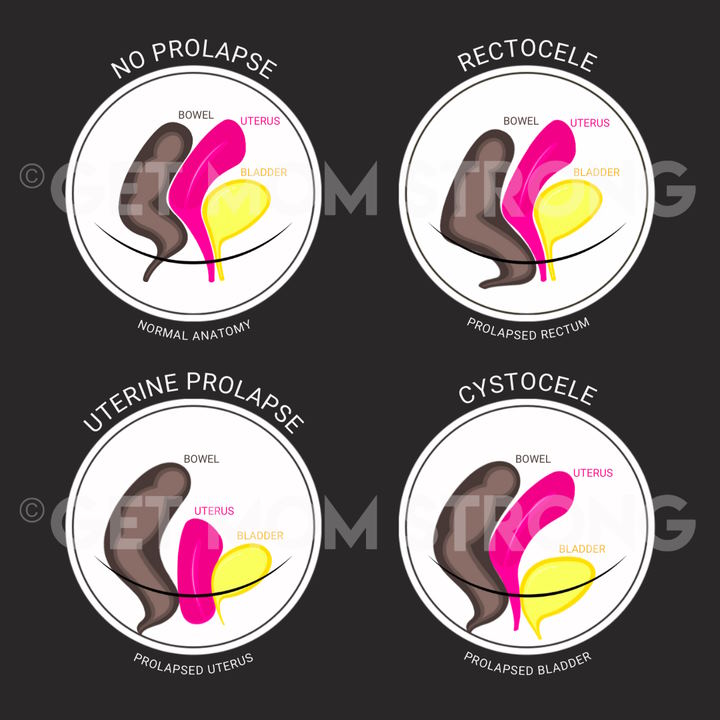Pelvic organ prolapse is a common occurrence after childbirth. In fact, one estimate shows that 90% of women who experience a vaginal delivery will also experience prolapse.
A postpartum diagnosis of prolapse can feel scary, but have hope. Prolapse after childbirth can typically be improved with proper training and body mechanics.
Prolapse After Childbirth
Postpartum prolapse occurs when the muscles and tissues that support your pelvic region weaken and stretch. As a result, one or more of the pelvic organs may sag or protrude into the vagina.
According to Dr. Margo Kwiatkowski, an orthopedic and pelvic floor physical therapist, pregnancy and childbirth is a common time to develop prolapse as the weight of the baby and strain of delivery can create additional damage to the fascia and ligaments in the pelvic region.
“Our tissues stretch three times their resting state during pregnancy. To expect our bodies to simply bounce right back postpartum without any implications isn’t realistic for many moms,” she said. “The good news is, with proper education and exercises, many women can improve their prolapse symptoms.”
Are There Different Types of Prolapse?
Yes. There are a few different types of prolapse. A pelvic floor physical therapist can evaluate to determine the prolapse type and the grade.
Cystocele: Bladder drops into the vagina.
Rectocele: The rectum bulges into the vagina.
Uterine Prolapse: Uterus drops into the vagina.
Vaginal Vault Prolapse: The top of the vagina loses its support and drops.

What are the Signs and Symptoms of Prolapse?
Common signs include:
- A feeling of heaviness around your lower tummy
- A sensation of a tampon falling out or something being “stuck” inside the vagina
- Feeling or seeing a bulge or lump coming out of your vagina
- Difficulties emptying bowels
- Significant urinary incontinence, feeling like your bladder is not emptying, or increased trips to the bathroom.
According to Dr. Kwiatkowski it is important to get checked out by a medical professional. “It is so important to have a pelvic floor physical therapist or physician do an examination because many of the prolapse symptoms can also be symptoms of a tight pelvic floor,” she said. “It may or may not be prolapse, so knowledge is power.”
How is a Prolapse Diagnosed?
You can check yourself for pelvic organ prolapse at home. However, it is recommended to see a physician or pelvic floor physical therapist for a proper diagnosis. A pelvic floor physical therapist will usually check you in the laying and upright position.
The practitioner is looking to see how far the pelvic organ descends past the hymen.
Prolapse is graded (0-4) by how far the organ drops into the vaginal canal.
“The grade of prolapse doesn’t necessarily correlate with the symptoms. Someone with a grade 1 prolapse may experience significant symptoms, while someone with a grade 2 may barely notice,” Dr. K says.
Grade 1
The uterus or vaginal walls have dropped slightly. Many women don’t even notice and it is diagnosed during a routine exam.
Grade 2
The uterus or vaginal walls have dropped further into the vagina and the bulge can be seen at the vaginal opening.
Grade 3
Most of the uterus or vaginal wall has fallen through the vaginal opening.
Grade 4
The organ is completely outside the entrance of the vagina.
What Causes Prolapse?
As mentioned, prolapse occurs when the muscles, connective tissue and ligaments that are supposed to hold our organs up—don’t.
A vaginal delivery is one of the most common direct causes of developing a prolapse. Other contributing factors include:
- Chronic constipation or straining during bowel movements
- Chronic coughing
- Heavy lifting without proper core engagement
- Menopause
“I don’t want women walking around thinking it is something they did or didn’t do in any given moment. You have to think about prolapse like a bunch of micro-traumas that led to the macro-trauma,” says Dr. Kwiatkowski. “You didn’t cause your prolapse, it just happened.”
Is Postpartum Prolapse Normal?
Prolapse after childbirth is very common, but is not necessarily normal. You can improve a prolapse and its symptoms with proper core pressure management, posture, exercises and support.
Prolapse is not life threatening, but can affect quality of life. If you feel symptomatic, it is important to get help.
How to Find Relief From Prolapse Symptoms
It is important to take a total body approach to prolapse healing.
1. Wear a pessary or support garment.
A pessary is small silicone device that is inserted into the vagina and used to support the pelvic organs. This can help you feel supported as you work on total body strength. A doctor or physical therapist can help you get fitted for one.
2. Learn to manage intra-abdominal pressure.
Your core is a pressure system. It is important to learn to breathe and engage your core during every day activities, especially when lifting.
3. Focus on improving posture.
If you are consistently slumped in daily life, it puts pressure down on your pelvic floor. Try to sit and stand more upright, especially when nursing and holding baby.
4. Learn to relax and contract your pelvic floor.
Many women guard their pelvic floor after being diagnosed with prolapse. Holding your pelvic floor tight can actually cause more issues and worsen prolapse symptoms.
5. Use gravity assisted positions when feeling symptomatic.
Place a pillow underneath your backside and elevate feet onto couch or chair. Focus on taking deep breaths to relax your pelvic floor.
Life After a Prolapse Diagnosis
Prolapse after childbirth is common, but there are many treatment options. A whole-body approach to healing is key. Strong Like A Mother has helped thousands of women improve their prolapse.
